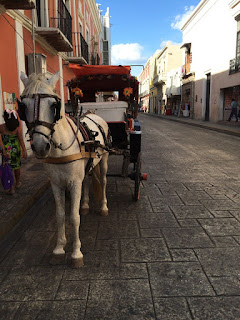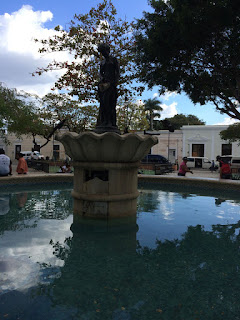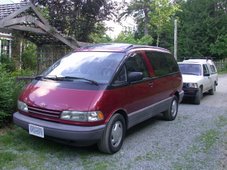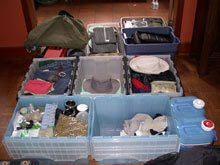Sunday, February 22, 2015
Happy fourth anniversary to Shannon and Levi, hope you have a great one!
Apparently we were on a toll road driving from Campeche to Merida. However, we were never charged toll, it was a very good highway. It took us a little over a two hours for the drive. Upon arriving in Merida we had Google maps direct us to RV Rainbow. It was quite an acceptable place to stay. We found other RV'ers from Quebec who had stayed there over two months. This made us feel comfortable because now we knew we had a reasonably priced place to stay in the big city.
Driving into the downtown we saw that the roadways were very wide surrounded by big tall trees. The sides of the roads were also very clean. We headed on into the Centro of Merida and found a safe, easy parking spot that we had to pay for.
Merida has a population of almost 1,000,000 people, that's without including its surrounding the municipalities. The city was founded in 1542. Wikipedia will help me with all the facts about Merida.
Walking into the Centro was a real eye-opener. We saw over-the-top colonial architecture., amazing hotels both inside and out with stained glass and filled with antiques. There were small plazas filled with people – some selling jewelry, some sitting at tables with umbrellas having drinks, others just sitting on benches cooling off. We saw several huge old churches, the main square with many vendors set up because it was Sunday, beautiful carriages being pulled by smallish horses, and heard a salsa dancer singing. We entered into a newish, huge, round shaped building which appeared to be some kind of gallery space. It was the Cuerpo Coleccion Museo Soumaya. We walked upstairs and were amazed by some of the art. Quite a few Salvador Dali bronze sculptures. We even saw paintings by Renoir. For all we know the other artists may have been famous but we just hadn't heard of them. It was great work, famous or not.
We went into a building next to the governors palace. It served as a restaurant and had small shops in the front. The interior walls with arches had brightly painted graphic pictures of local flowers, huge size of course. Upstairs in the gallery space were paintings of famous Mexican singers.
We moved on from there to the governors' palace. Besides the amazing Mexican architecture we saw huge paintings depicting struggles from the past and those heroes who tried to emancipate the common folk.
Ken found an amazing deal on a hotel called the Santa Ana.
Monday, February 23, 2015
Todays seem to be particularly Hot days.
It could be just us getting used to the heat and humidity of the Yucatan Peninsula. We weren't really smart about the time of day we went out walking. We probably went out at the hot hottest part of the day. There's an extreme amount of things to do here in Merida. We have to have a theme or some kind of reasoning behind what we do each day. Today we are going to try to look at Parks and their are accompanying churches. In the older part of town the neighborhoods are called colonias or barrios.
We are staying in the hotel Santa Ana so the closest closest park and church to us is the Santa Ana. The little church of Santa Anna faces on to Calle 60 at Calle 45. It was found in the 1500s and rebuilt in the 1700s. The church appears to be built on a raised platform and it could be a former Mayan temple platform. Back in the day Santa Anna was the city's farm and there were plantations that grew food.
Today the Santa Ana neighborhood appears to be quite fast paced. This is an area where some ex-pats have chosen to live. The restaurants and shops are based around the square.
We decided to walk through the centre of Merida and do the churches at another time. We went to the San Juan area. It is one of the oldest colonias in the centro area. In colonial times it was a barrio for the Indians, but became a nice place. San Juan is probably the most historically important park. What we saw as an entrance into the neighbourhood was the San Juan arch which was painted yellow. It was built in 1690 and is at the south end of the park. It was once at the beginning of a road that led to Campeche. If you can see the San Juan arch has a very unique shape. The San Juan church was built between 1769 and 1770. The sculptural fountain in the park was brought from Paris at the beginning of the 20th century. La Negrita (the statue from France, made of a black material and thus named ‘the little black one’) is back where she belongs in the fountain, once the park had been refurbished.
Next up was a home called the Casa Del Culcal Kin. This is not a home that we could go into but it obviously had been an important home many years ago and was very old. There was a plaque on the side of the home saying Patrimonio de la Nacion (heritage of the nation).
By this time on our little journey it was extremely hot out. At least to us it seemed extremely hot and we probably should've went someplace and taken a rest but somehow we journeyed on.
The next two areas I'm going to talk about together Ermita and San Sabastion. This is an area south of the Zocola. Barrio Bravo was the name given to San Sebastian in the early 20th century. It was a dangerous area where young man fought amongst themselves especially with young man from the neighbouring Ermita. This was the area where the disenfranchised local Mayans and lower class immigrants lived hundreds of years. Now
Extranjeros (Foreigners) are moving into the area.
In the 1700s the Ermita church was originally built. It was dedicated to Nuestra Señora del Buen Viaje (Our Lady of the Good Journey… Merida’s local equivalent of Saint Christopher). Two sides of the old church are still surrounded by botanical gardens and very old fig trees dripping with roots and vines.
The next neighborhood was called Centenario. This area around and behind the Parque Centenario Zoo was once called the Barrio de Santa Catrina and was part of Santiago. It has a bit of a sad history which was quite surprising to me since now there is a huge zoo in the area. There was a penitentiary there and also a hospital. During the time of Porfirio Diaz’ nationwide building projects the zoo entrance gate and the rest of the zoo was constructed. We will leave exploring the zoo for another day.
Santa Lucia was our next Colonia and it is the closest to the Plaza Grande. It is a small neighborhood that used to be full of shops but now it is very influenced by the influx of ex-pats and there are a lot of restaurants in the area. Just three blocks north of the Plaza Grande is the salmon colored Santa Lucia church on the corner of Calle 60 and Calle 55. This is a very artsy area where on Sundays other special occasions artisans are set up selling their work. This park contain sculptures of famous Yucateco musicians.
That was our day! We were too tired and hot to even go out for supper. It's very hard to walk over 13 km in this heat and humidity.
The factual information was gathered from signs on the sites and from Yucatan Living.
Tuesday, February 24, 2015
Walked about 10 km looking for restaurants.
Today's theme in Merida is finding vegetarian restaurants. We used Trip Adviser as our guide. The day before I had gone to many restaurants to try and find something to eat on their menu. Generally I would say that Merida is a very meaty town. I noticed that they actually eat a lot of turkey, something that is not on this vegetarian's diet.
This day we were a little smarter and did not go out into the very hottest part of the day. We did walk about 10 km. We did walk to all of these restaurant, some were open and some were not.
Throughout our time in Merida we will try and visit the restaurants and give a bit of a critique. We are not food critics we just like food, and me, especially vegetarian. We have eaten in vegetarian restaurants all across Mexico, the United States and Canada, so we have a bit of an idea of what we're talking about.
Él Jardin de Santa Ana
This is the closest vegetarian restaurant to the Hotel Santa Ana. It's just not open until 1 PM so the first time we went by it was closed. It is open late in the evening. You can sit outside in the garden or you can sit inside. We went for a late supper so we didn't want to eat too much and split a plate of four potato and soya chorizo tacos. They were very flavourful. Instead of serving salsa sauce they served a type of vegetable type of cooked vegetable (I think it was squash) chopped with a bit of tomato sauce. We had a green drink called Chaya. It was absolutely delicious as an appetizer with nacho chips.
Él Jardin de Santa Ana is a vegetarian restaurant and I would definitely return to as there are lots of other great options on the menu. When you go there you need to ask specifically for the vegetarian menu. They usually put up a carnivore menu. When they brought the bill they also but brought a live flower for patrons to take home, nice touch.
Salvia
We went to a restaurant called Salvia which was also within easy walking distance of the hotel. It's a very big space because of the tall ceilings It's decorated in sort of a health food, hippie, East Indian motif. The staff is very friendly and could speak limited English. They have a comida corrida for each day. We went on a Thursday and one of the options was a hamburger with brown rice and a salad with the actual option of salad dressing along with the hamburger with all the trimmings in a bun. All of this was absolutely delicious, it left me wanting a second hamburger. They also served a wonderful green sauce which was sort of a cilantro type of sauce which did not have any kind of picante to it. The meal began with soup. Ken had a cream of chayote squash soup and I had a carrot and rice soup - delicious on both counts.
We both had fruit drinks Ken's was pineapple and mine was mamay. This is a restaurant I am planning to return to for one of the other comida corridas.
Bistro Ave Del Paraiso
Bistro Ave Del Paraiso was a great supper spot. This restaurant serves Thai food, although it has a limited menu it had absolutely delicious food. At the time I'm writing this they served beer. The waitress said that you were allowed to bring your own bottle of wine if you wanted to because they do not have the proper license for serving it right now.
We chose a yellow vegetable curry for our meal. Rice comes with, served on a banana leaf. It had just the right amount of heat so the full flavor of the curry could shine through. This is another restaurant that you could bring a meat eater too. They make the entire dish then they add any meat or shrimp to what they already have cooked.
We are anxious to return with our bottle of wine.
Rescoldos Mediterranean Bistro
Rescoldos Mediterranean Bistro was very close to our Hotel. It's a dinner bistro that opens after 6 PM. It has lots of vegetarian options, your meat eating friends could also join you. Ken and I chose to share a Blanco pizza. This pizza had fried onions and garlic feta cheese and mozzarella cheese and was absolutely delicious. Something we've never tried before was putting extra virgin olive oil on our pizza. Likely little bit over-the-top fattening but was delicious. Ken had not tried putting the dried peppers on his pizza before, well he shook them on and love them. This was a restaurant with a great Mediterranean atmosphere, you could sit inside or outside. We choose the outside in a wonderful garden with the big fountain.
Maiz, Canela y Cilantro
Maiz, Canela y Cilantro was a was a wonderful vegetarian restaurant where you would eat inside. This restaurant is only open for breakfast and for lunch not dinner. This is another place where you can bring your eat meat eating friends and family. We went on Saturday so the comida corrida was not happening. They do have a comida corrida Monday to Friday Ken and I had enchiladas, my meal was corn tortillas filled with vegetables then topped with a chocolate Mola sauce. Ken's meal was the same except his tortillas were filled with chicken and the salsa was a green or Verde salsa likely made of tomatillos. Good manners aside I would have licked my plate if I'd had the chance. The place was decorated in a charming manner. The cook/friendly waitress seemed to be quite at home in her own kitchen at the back the restaurant. Supposedly the food would take a long time to get to us, however, we met a lovely couple from Ottawa, Canada. John and Heather engaged us in conversation about our travels and about Merida.
We will return to this restaurant with the home-cooked meals during a time when they're serving comida corrida.
Restaurante Amaro
Restaurante Amaro is a partly veggie restaurant that serves omnivores as well. It is located in a very old colonial building in the centro (centre of town), Calle (street) 59. In fact, from the 1700's it is the birthplace of Andres Quintana Roo. They often have live tova music later in the evenings. The walls hold the art of local artists and at the time we were there it was good art indeed. The service is impeccable with professional waiters catering to your every need. The food, oh the food! My choice, the eggplant "Mesre", (stuffed Arab style). According to the menu this is breaded eggplant, stuffed with grated vegetables and cheese, then topped with "Koal" (mild, white Yucetacan sauce) with rice on the side. It was melt in your mouth delicious. I have had this dish twice and both times I was over the top delicious. Another night I had the veggie eggplant curry - fried, battered eggplant, curried in tomato sauce, topped with cheese and a tomato sauce. This also came with rice. It was good beyond the ordinary.
Wednesday, February 25, 2015
Our theme for today was our walk up the Paseo Montejo.
This was about a block and a half walk from our hotel Santa Ana. We walked about 3 km of the Paseo and then back.
The Paseo Montejo is the main boulevard of Merida. It is in a very fashionable, elegant district. Its tree-lined, wide roads are also very busy with traffic. It has many mansions from the 19th century to show off. The houses were built during the boom of the henequen industry in Merida. These lovely mansions have been converted into office buildings, museums, boutique hotels, shops, office buildings, restaurants and museums. etc.
We saw Merida’s Monumento a la Bandera (Flag Monument) and Museo Regional de Antropologia (Regional Anthropology Museum) which is housed in the pink Palacio Canton, one of the grandest mansions along the boulevard. We saw a beautiful pink painted mansion that had been converted into a spa and also for other uses. Of interest to me in particular was a big old corner mansion that had been converted into a store that sold sewing machines and thread etc. It was different, however, in that it was huge and a mansion, who's seeing that NOB.
We found the most amazing Starbucks. It was on two levels, we sat upstairs. There was also an outside courtyard along with original art on the walls.
There was a restaurant called Cibaro. This place sported the most amazing art on the outside walls. There was also a spiral staircase that was also arted up.
We walked as far as the Monumento de la Patrio (monument to the flag) which is at the busiest roundabout in Merida. According to En-Yucatan the piece was the work of sculpture Romulo Rozo. His work shows us an important part of Mexico's history from the founding of Tenochtitlan until mid-twentieth century. The view from across the street was absolutely amazing. It's a very powerful piece.
We ate lunch again at Chaya Maya. Yum! We walked only about 8.95 Km today.
Thursday, February 26, 2015
We went to the Palacio Canton Regional Museum of Anthropology built on the Paseo de Montejo.
The building itself is very striking and was constructed in the late 19th century. It takes its name from General Francisco Canton Rosado. He was governor of the Yucatán during Porfirio Diaz's presidency. This building, had then been a family home. In 1980 it became what it is today. Most of the building materials were imported from France Italy and Germany. The building is done in the French Eclectic style combining both neoclassical and baroque. You can pick up a brochure from the museum that tells all about the building.
They have both of permanent exhibit and one that changes more frequently. On the main floor of this awe inspiring building was the Tonala Talaquepaque Una Vision Del Bajio, a display of artistically significant, high-quality pottery from the state of Jalisco.
Signage was in Spanish and in English and gave a good description of the process from clay in the ground and these magnificent works of art. They had even gone as far as creating small clay figures of people producing these pieces of art. They showed people digging up the clay, the donkeys hauling the clay, artists fashioning the clay into pots, other artists doing the painting and others putting the clay into the huge ovens via ladders. It also showed the poor artisans hauling their wares on their back to market.
The main part of the exhibit, however, was of exquisitely fashioned pots of all sizes from a half an inch high to approximately 4 feet high. They came in all shapes from the shape of animals such as roosters to more classic shapes and round huge bowl shapes. The painting was done by hand and was flawless. If it was possible you needed to look at all sides of the pot, different animals or flowers could be painted on different sides of the pot.
The more permanent exhibit was up the Carrara marble stairway. The exhibit was called Codico Puuc Arquitectura y Simbolismo (Architecture and Symbolism).
Pre-Columbian Mayan architecture was made with variety of materials and used many complex forms. Puuc architecture was what this second floor of the museum was all about. The architecture and symbolism of this era allows us to understand more the thinking and living in the pre-Columbian world.
The signage was both in Spanish and in English so I will try to include some of the signage for you to take a look at.
The hottest part of the day was spent inside at the hotel. But we did manage to make it out in the evening. After supper we saw an interesting looking building that we thought was a restaurant. Once encouraged to come inside we realized it was an art opening. I was lucky enough to have one of the artists come over and talk to me in English about his work. Continuing on our walk we went by St. Lucia Park we heard traditional music and saw folkloric dancers in full costume. We saw the usual number of horse drawn carriages. At one crosswalk I even got the privilege of petting one of these wonderful steeds. She was trying to sleep standing up. Must of been tired from the heat of the day. Only in Mexico you say, I would have to agree.









































































































































No comments:
Post a Comment